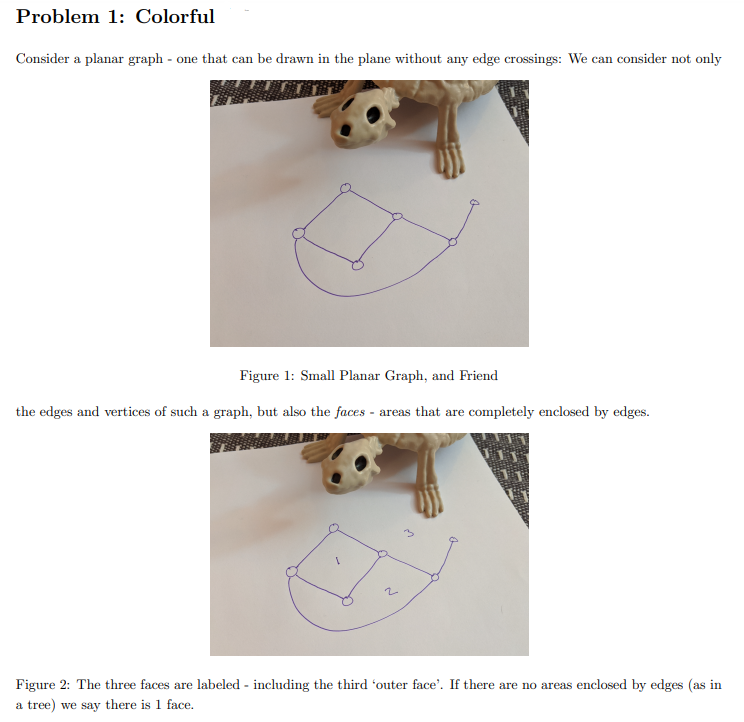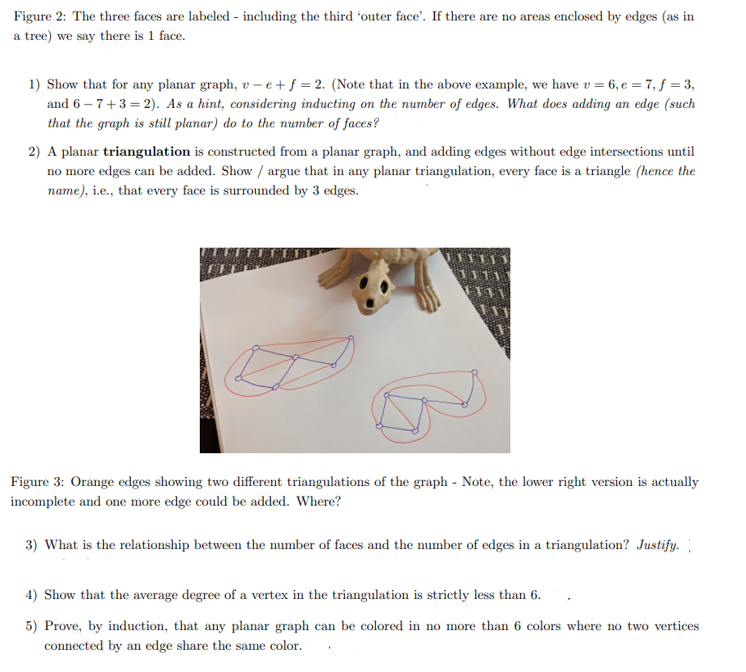2) A planar triangulation is constructed from a planar graph, and adding edges without edge intersections until no more edges can be added. Show / argue that in any planar triangulation, every face is a triangle (hence the name), i.e., that every face is surrounded by 3 edges. Figure 3: Orange edges showing two different triangulations of the graph - Note, the lower right version is actually incomplete and one more edge could be added. Where? 3) What is the relationship between the number of faces and the number of edges in a triangulation? Justify.
2) A planar triangulation is constructed from a planar graph, and adding edges without edge intersections until no more edges can be added. Show / argue that in any planar triangulation, every face is a triangle (hence the name), i.e., that every face is surrounded by 3 edges. Figure 3: Orange edges showing two different triangulations of the graph - Note, the lower right version is actually incomplete and one more edge could be added. Where? 3) What is the relationship between the number of faces and the number of edges in a triangulation? Justify.
Advanced Engineering Mathematics
10th Edition
ISBN:9780470458365
Author:Erwin Kreyszig
Publisher:Erwin Kreyszig
Chapter2: Second-order Linear Odes
Section: Chapter Questions
Problem 1RQ
Related questions
Question
please send handwritten solution for Q3

Transcribed Image Text:Problem 1: Colorful
Consider a planar graph - one that can be drawn in the plane without any edge crossings: We can consider not only
Figure 1: Small Planar Graph, and Friend
the edges and vertices of such a graph, but also the faces - areas that are completely enclosed by edges.
Figure 2: The three faces are labeled - including the third 'outer face'. If there are no areas enclosed by edges (as in
a tree) we say there is 1 face.

Transcribed Image Text:Figure 2: The three faces are labeled - including the third 'outer face'. If there are no areas enclosed by edges (as in
a tree) we say there is 1 face.
1) Show that for any planar graph, v – e + f = 2. (Note that in the above example, we have v = 6, e = 7, f = 3,
and 6 – 7+3 = 2). As a hint, considering inducting on the number of edges. What does adding an edge (such
that the graph is still planar) do to the number of faces?
2) A planar triangulation is constructed from a planar graph, and adding edges without edge intersections until
no more edges can be added. Show / argue that in any planar triangulation, every face is a triangle (hence the
name), i.e., that every face is surrounded by 3 edges.
Figure 3: Orange edges showing two different triangulations of the graph - Note, the lower right version is actually
incomplete and one more edge could be added. Where?
3) What is the relationship between the number of faces and the number of edges in a triangulation? Justify.
4) Show that the average degree of a vertex in the triangulation is strictly less than 6.
5) Prove, by induction, that any planar graph can be colored in no more than 6 colors where no two vertices
connected by an edge share the same color.
Expert Solution
This question has been solved!
Explore an expertly crafted, step-by-step solution for a thorough understanding of key concepts.
This is a popular solution!
Trending now
This is a popular solution!
Step by step
Solved in 2 steps with 1 images

Recommended textbooks for you

Advanced Engineering Mathematics
Advanced Math
ISBN:
9780470458365
Author:
Erwin Kreyszig
Publisher:
Wiley, John & Sons, Incorporated

Numerical Methods for Engineers
Advanced Math
ISBN:
9780073397924
Author:
Steven C. Chapra Dr., Raymond P. Canale
Publisher:
McGraw-Hill Education

Introductory Mathematics for Engineering Applicat…
Advanced Math
ISBN:
9781118141809
Author:
Nathan Klingbeil
Publisher:
WILEY

Advanced Engineering Mathematics
Advanced Math
ISBN:
9780470458365
Author:
Erwin Kreyszig
Publisher:
Wiley, John & Sons, Incorporated

Numerical Methods for Engineers
Advanced Math
ISBN:
9780073397924
Author:
Steven C. Chapra Dr., Raymond P. Canale
Publisher:
McGraw-Hill Education

Introductory Mathematics for Engineering Applicat…
Advanced Math
ISBN:
9781118141809
Author:
Nathan Klingbeil
Publisher:
WILEY

Mathematics For Machine Technology
Advanced Math
ISBN:
9781337798310
Author:
Peterson, John.
Publisher:
Cengage Learning,

